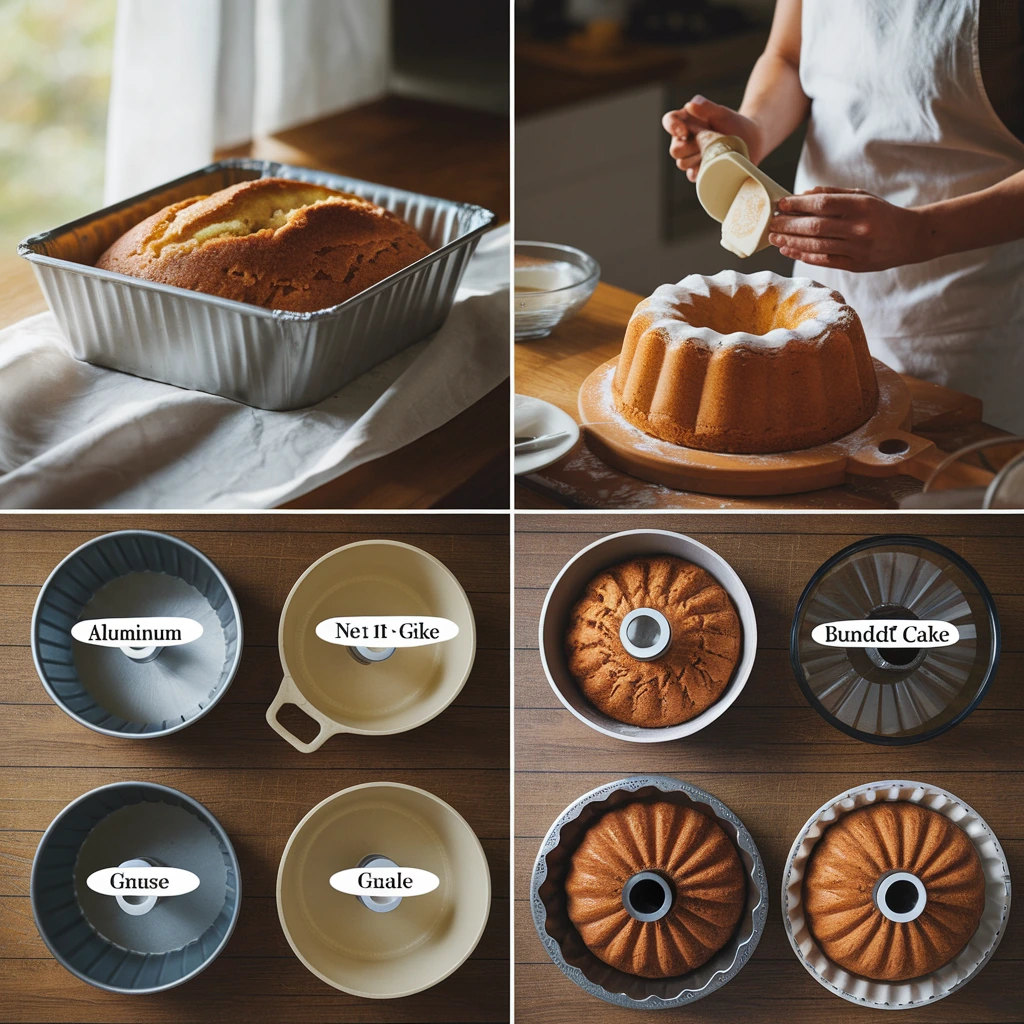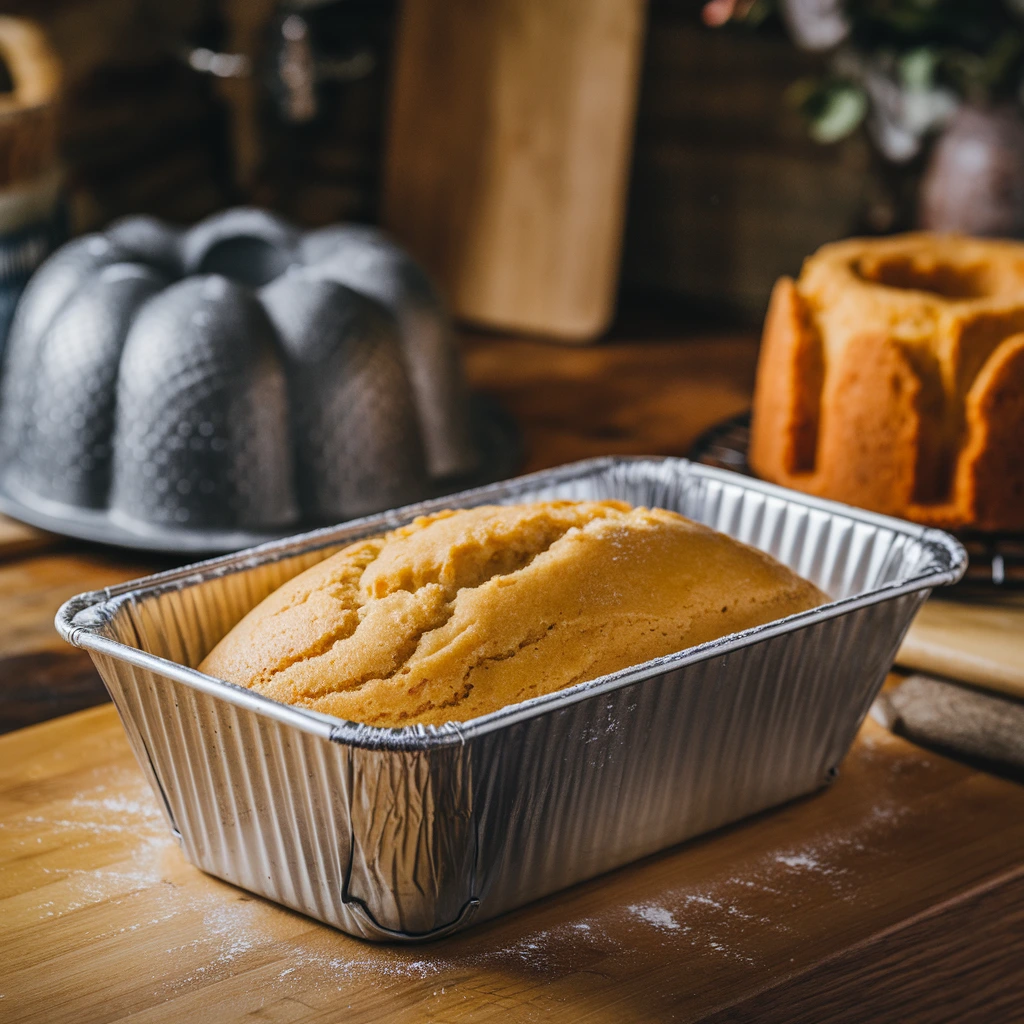Baking a perfect pound cake starts long before you mix the ingredients—it begins with choosing the perfect pound cake pan! The type, size, and material of your pan can make or break your bake, affecting everything from texture to even browning. A poorly chosen or improperly prepared pan can lead to sticking, dryness, uneven baking, or even a sunken center.
If you’ve ever struggled with a pound cake that didn’t turn out as expected, you might be making some common baking mistakes. Learn how to avoid them in this detailed guide on pound cake baking mistakes so you can fix errors before they happen!
In this post, we’ll explore how to choose the perfect pound cake pan, how to prep it for flawless baking, and expert techniques to achieve soft, evenly baked cakes every time. Plus, for more professional baking tips, check out this expert guide on cake pan materials from Serious Eats.
Ready to take your pound cake baking to the next level? Let’s dive in! 🍰✨
How to Choose the Perfect Pound Cake Pan
Aluminum, Stainless Steel, or Non-Stick? Which is Best?
The material of your pan has a direct impact on how your pound cake bakes. Aluminum pans are the best choice for even heat distribution, preventing overbrowning and underbaking. Stainless steel pans are durable but don’t conduct heat as well, leading to longer baking times. Non-stick pans help with easy release, but dark coatings tend to absorb more heat, which can result in overbaked edges. If using non-stick, opt for a light-colored pan to prevent excessive browning. Silicone pans, while flexible, can produce cakes with a softer crust due to poor heat conduction. The best choice for a balanced bake is an aluminum or light-colored non-stick pan.
Bundt Pan vs. Loaf Pan: Which One Should You Use?

The shape of the pan matters just as much as the material. Bundt pans have a center tube that promotes even baking, ensuring the middle of the cake is cooked thoroughly without overbaking the edges. Loaf pans, on the other hand, require longer baking times because of their solid structure, which can lead to uneven baking if not carefully monitored. If switching between the two, adjust baking times accordingly. A loaf cake might need an extra 10-15 minutes, while a Bundt cake benefits from the central heat flow for even rising.
Finding the Right Cake Pan Size for Your Recipe
Pound cake batter expands as it bakes, so using the wrong pan size can cause problems. A 9×5-inch loaf pan typically holds 8 cups of batter, while a 10- or 12-cup Bundt pan can handle larger amounts. If the pan is too small, the batter will overflow, creating a mess in your oven. If it’s too large, the cake may not rise properly, leading to a flatter texture. To get consistent results, always fill the pan about ⅔ full, leaving space for the batter to rise.
Prepping Your Cake Pan for Perfect Baking
The Best Way to Grease Your Pan for Easy Cake Release
Even if you’re using a non-stick pan, greasing it properly is crucial for an easy release. Butter alone can sometimes burn and create a sticky residue, so using butter with a light dusting of flour is the best method. If using oil, avoid sprays containing lecithin, which can build up over time and affect non-stick coatings. For Bundt pans, make sure to coat every crevice with melted butter or a baking spray that includes flour.
When and How to Use Parchment Paper in Cake Pans
Parchment paper can make unmolding pound cakes much easier, especially when baking in loaf pans. Cut a strip that extends over the edges of the pan, creating handles for lifting the cake out once it’s cooled. This prevents breaking and sticking, particularly if the cake is delicate or extra moist. For Bundt cakes, parchment paper is not an option, so a well-greased and floured pan is essential.
Preventing Uneven Baking and Hot Spots in the Oven
If your pound cake bakes unevenly, the issue might not be the pan but the oven itself. Many ovens have hot spots that cause cakes to brown unevenly or rise lopsided. Using an oven thermometer ensures you’re baking at the correct temperature. Additionally, rotating the pan halfway through baking can promote even heat distribution. If your oven runs hot, placing a baking stone on the lower rack can help regulate temperature and prevent burnt edges.
Baking Tips for a Soft, Evenly Baked Pound Cake

Setting the Right Oven Temperature for Even Baking
Baking at the correct temperature is key to achieving a moist, evenly baked pound cake. 325°F (163°C) is ideal, as higher temperatures can lead to cracked tops and dry interiors. Avoid opening the oven door too soon, as sudden temperature drops can cause the cake to sink. If using a glass or dark-colored pan, consider reducing the oven temperature by 25°F to prevent overbrowning.
How to Avoid Overbaking and Keep Cakes Moist
Overbaked cakes turn out dry and crumbly, so it’s important to monitor baking time closely. The golden-brown color test is a good indicator, but the toothpick test is more reliable—insert a toothpick into the center, and if it comes out with a few moist crumbs, the cake is done. Another method is the spring-back test—lightly press the top of the cake; if it bounces back, it’s fully baked.
Cooling and Unmolding Your Pound Cake the Right Way
Letting the cake cool properly prevents texture issues. If it cools too long in the pan, condensation can form, making the cake soggy. On the other hand, unmolding too soon can cause it to break. The best practice is to let the cake cool in the pan for 10-15 minutes, then transfer it to a wire rack to cool completely. If a Bundt cake is sticking, gently loosen the edges with a plastic knife and let it sit upside down on a rack until it releases.
Common Cake Pan Problems & How to Fix Them
Cake Sticking to the Pan? Here’s How to Fix It!
If your cake refuses to come out, don’t force it. First, tap the bottom of the pan gently to loosen it. If that doesn’t work, place a warm towel over the pan for a few minutes to help release the cake. To prevent this issue in the future, ensure you’re greasing and flouring the pan thoroughly before pouring in the batter.
Why Does My Cake Have Uneven Browning or Cracks?
Cracked tops and uneven browning are usually caused by baking at too high a temperature or an oven with hot spots. To avoid this, always preheat your oven properly and use an oven thermometer to verify accuracy. If cracks still occur, try reducing the oven temperature slightly or using an insulated baking strip around the pan to help control heat distribution.
Dense, Dry, or Sunken Cakes: What Went Wrong?
A dense cake often means the batter was overmixed, causing excess gluten formation. A dry cake is usually the result of overbaking or too much flour. A sunken center is typically due to underbaking or too much leavening. To avoid these problems, follow the recipe precisely, measure ingredients accurately, and ensure the cake is fully baked before removing it from the oven.
Conclusion
Using the right cake pan, greasing method, and baking technique can make all the difference when baking a pound cake. The correct pan material and size, proper oven temperature, and careful baking time monitoring will help you achieve the perfect pound cake every time. Follow these tips, and you’ll never struggle with sticking, cracking, or uneven baking again.
Try these techniques in your next bake, and enjoy a flawlessly baked pound cake with a soft, moist texture. If you’re looking for more expert baking tips, check out this guide on cake pan materials to enhance your baking skills.
How to Choose the Perfect Pound Cake Pan
Aluminum, Stainless Steel, or Non-Stick? Which is Best?
The material of your pan has a direct impact on how your pound cake bakes. Aluminum pans are the best choice for even heat distribution, preventing overbrowning and underbaking. Stainless steel pans are durable but don’t conduct heat as well, leading to longer baking times. Non-stick pans help with easy release, but dark coatings tend to absorb more heat, which can result in overbaked edges. If using non-stick, opt for a light-colored pan to prevent excessive browning. Silicone pans, while flexible, can produce cakes with a softer crust due to poor heat conduction. The best choice for a balanced bake is an aluminum or light-colored non-stick pan.
Bundt Pan vs. Loaf Pan: Which One Should You Use?
The shape of the pan matters just as much as the material. Bundt pans have a center tube that promotes even baking, ensuring the middle of the cake is cooked thoroughly without overbaking the edges. Loaf pans, on the other hand, require longer baking times because of their solid structure, which can lead to uneven baking if not carefully monitored. If switching between the two, adjust baking times accordingly. A loaf cake might need an extra 10-15 minutes, while a Bundt cake benefits from the central heat flow for even rising.
Finding the Right Cake Pan Size for Your Recipe
Pound cake batter expands as it bakes, so using the wrong pan size can cause problems. A 9×5-inch loaf pan typically holds 8 cups of batter, while a 10- or 12-cup Bundt pan can handle larger amounts. If the pan is too small, the batter will overflow, creating a mess in your oven. If it’s too large, the cake may not rise properly, leading to a flatter texture. To get consistent results, always fill the pan about ⅔ full, leaving space for the batter to rise.
Prepping Your Cake Pan for Perfect Baking
The Best Way to Grease Your Pan for Easy Cake Release
Even if you’re using a non-stick pan, greasing it properly is crucial for an easy release. Butter alone can sometimes burn and create a sticky residue, so using butter with a light dusting of flour is the best method. If using oil, avoid sprays containing lecithin, which can build up over time and affect non-stick coatings. For Bundt pans, make sure to coat every crevice with melted butter or a baking spray that includes flour.
When and How to Use Parchment Paper in Cake Pans
Parchment paper can make unmolding pound cakes much easier, especially when baking in loaf pans. Cut a strip that extends over the edges of the pan, creating handles for lifting the cake out once it’s cooled. This prevents breaking and sticking, particularly if the cake is delicate or extra moist. For Bundt cakes, parchment paper is not an option, so a well-greased and floured pan is essential.
Preventing Uneven Baking and Hot Spots in the Oven
If your pound cake bakes unevenly, the issue might not be the pan but the oven itself. Many ovens have hot spots that cause cakes to brown unevenly or rise lopsided. Using an oven thermometer ensures you’re baking at the correct temperature. Additionally, rotating the pan halfway through baking can promote even heat distribution. If your oven runs hot, placing a baking stone on the lower rack can help regulate temperature and prevent burnt edges.
Baking Tips for a Soft, Evenly Baked Pound Cake
Setting the Right Oven Temperature for Even Baking
Baking at the correct temperature is key to achieving a moist, evenly baked pound cake. 325°F (163°C) is ideal, as higher temperatures can lead to cracked tops and dry interiors. Avoid opening the oven door too soon, as sudden temperature drops can cause the cake to sink. If using a glass or dark-colored pan, consider reducing the oven temperature by 25°F to prevent overbrowning.
How to Avoid Overbaking and Keep Cakes Moist
Overbaked cakes turn out dry and crumbly, so it’s important to monitor baking time closely. The golden-brown color test is a good indicator, but the toothpick test is more reliable—insert a toothpick into the center, and if it comes out with a few moist crumbs, the cake is done. Another method is the spring-back test—lightly press the top of the cake; if it bounces back, it’s fully baked.
Cooling and Unmolding Your Pound Cake the Right Way
Letting the cake cool properly prevents texture issues. If it cools too long in the pan, condensation can form, making the cake soggy. On the other hand, unmolding too soon can cause it to break. The best practice is to let the cake cool in the pan for 10-15 minutes, then transfer it to a wire rack to cool completely. If a Bundt cake is sticking, gently loosen the edges with a plastic knife and let it sit upside down on a rack until it releases.
Common Cake Pan Problems & How to Fix Them
Cake Sticking to the Pan? Here’s How to Fix It!
If your cake refuses to come out, don’t force it. First, tap the bottom of the pan gently to loosen it. If that doesn’t work, place a warm towel over the pan for a few minutes to help release the cake. To prevent this issue in the future, ensure you’re greasing and flouring the pan thoroughly before pouring in the batter.
Why Does My Cake Have Uneven Browning or Cracks?
Cracked tops and uneven browning are usually caused by baking at too high a temperature or an oven with hot spots. To avoid this, always preheat your oven properly and use an oven thermometer to verify accuracy. If cracks still occur, try reducing the oven temperature slightly or using an insulated baking strip around the pan to help control heat distribution.
Dense, Dry, or Sunken Cakes: What Went Wrong?
A dense cake often means the batter was overmixed, causing excess gluten formation. A dry cake is usually the result of overbaking or too much flour. A sunken center is typically due to underbaking or too much leavening. To avoid these problems, follow the recipe precisely, measure ingredients accurately, and ensure the cake is fully baked before removing it from the oven.
Conclusion
Using the right cake pan, greasing method, and baking technique can make all the difference when baking a pound cake. The correct pan material and size, proper oven temperature, and careful baking time monitoring will help you achieve the perfect pound cake every time. Follow these tips, and you’ll never struggle with sticking, cracking, or uneven baking again.
Try these techniques in your next bake, and enjoy a flawlessly baked pound cake with a soft, moist texture. If you’re looking for more expert baking tips, check out this guide on cake pan materials to enhance your baking skills.

